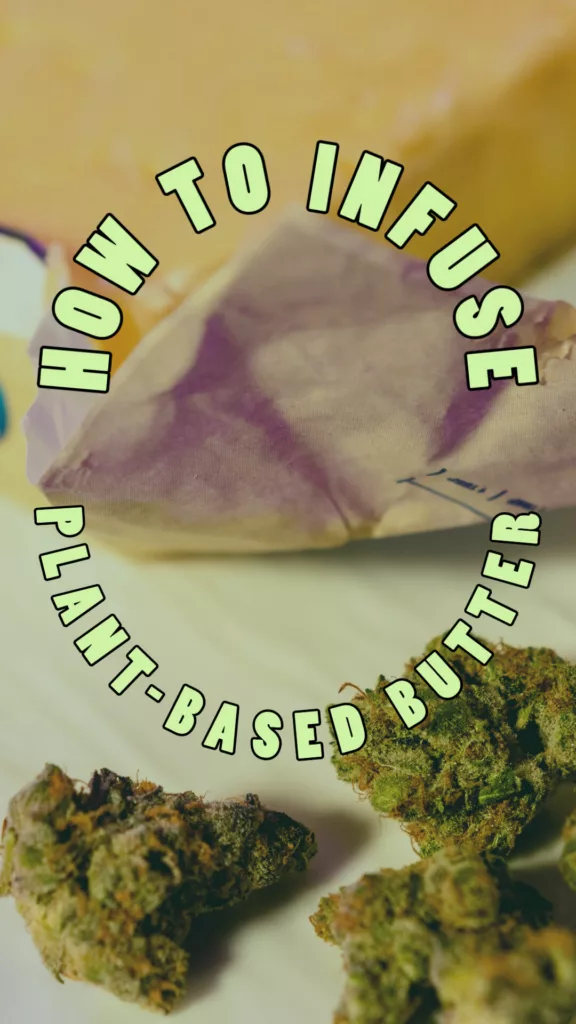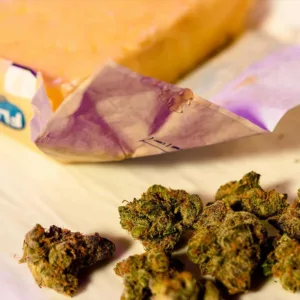One request I’ve received from subscribers/followers frequently is to add more vegan/plant-based options to the mix. And I get it. Whether it’s because of allergies or moral objections, it is of no consequence to me. I want to provide guidance wherever it is needed.
Infusing non-dairy butter is not that different from infusing cow butter or coconut oil. Plant butter is made with vegetable oils, lecithin, and water. So the same basic principles and processes apply. You’ll start by decarbing the flower and mixing the plant butter and cannabis with some heat.
How to choose plant-based butter
When selecting a vegan butter for your infusion, not all vegetable butter is made equally. A lot of the plant-based butter options are “spreadable butter.” For baked goods, it’s best to avoid these. Find a stick of butter with the highest fat content you can get your hands on.
I wrote a more in-depth article about selecting plant butter to give you a more detailed guide to choosing suitable plant-based butter. You can read that here.
Your primary focus, however, should be fat content and that it comes in stick form. You want something that will mimic regular butter the closest. The butter you choose should be firm in the fridge and softened at room temperature. And whatever you pick should have a similar fat content as dairy butter. Avoid butter alternatives that are “spreadable.”
Step 1: Activating THC in cannabis flower
Once you’ve chosen your butter alternative and are ready to begin the infusion process, start by decarboxylating, or decarbing, the cannabis buds.
How to quickly decarb cannabis for THC infusions:
- Preheat oven to 300 degrees Fahrenheit
- Break up cannabis flower into evenly sized pieces, about the size of peas, to popcorn kernels
- Spread cannabis in an even layer on a baking sheet. Cover with foil.
- Bake for 15 minutes. Let the pan cool to room temperature, covered, before moving on to the next step.
The traditional decarb method:
Most edible makers on the internet will typically recommend a slightly different set of times and temperatures for decarbing. The method described above is the same, except the oven is set to 240 degrees Fahrenheit and the flower is baked for 40-50 minutes. Some might say 30 minutes.
One thing I can say is that it doesn’t matter which method you use for decarbing, and you should try different ways until you get a feel for what works for you and the equipment/utensils.
Step 2: Infusing plant-based butter
Ingredients
- 3.5 grams decarboxylated cannabis flower
- 113 grams/4 ounces/1 stick vegan/plant-based butter
Equipment/Tools
- Oven-safe glass jar and lid
- Slow Cooker/Crockpot OR sauce pot deep enough for the jar
- Cheesecloth
- Mesh strainer
- Clean airtight jar/container for storage
- Tea towel
- Large liquid measuring cup*
- Funnel*
*denotes optional
Steps
- In an oven/heat-safe glass jar, combine the butter and decarboxylated cannabis flower. Close the lid tight enough to create a seal but not too tight that it’s unable to be opened later.
- Note: the heat will cause a vacuum effect on the lid. Do not over-tighten.
- To protect the jar, line the bottom of the saucepot or slow cooker with a tea towel. Place the jar on a towel and add water until it comes past the butter/flower line in the jar. Cover pot/slow cooker.
- If using a sauce pot, bring water to a light boil and simmer for 30 minutes up to 2 hours. If the jar is too tall to leave the lid on, replenish the water as needed with HOT water only. Pouring cold water into the pot will cool the water too much and could risk cracking the glass due to a rapid temperature change. Hot water from the sink tap should be fine.
- If using a slow cooker or crock pot, set it high for 4 hours, and walk away.
- At the end of the infusion time, remove the jar from the pot and let it come to room temperature.
- Line a mesh strainer with cheesecloth, and strain the flower from the butter into a large liquid measuring cup. Squeeze the cheesecloth to get all of the goodness out.
- Pour the freshly strained melted butter into an airtight container or mold and store it in the refrigerator for up to 30 days (possibly longer if stored well and it’s mold-free). Freezing will extend the life of the infused butter up to 6 months.
Final thoughts
Whether using cow milk butter or vegetable butter, remember that the most important part is finding a butter or fat medium that works for you and your recipes and needs. Don’t let overthinking about the type of butter hold you back from learning new skills in the kitchen. I promise you it’s entirely doable to infuse your butter at home. And if you still run into issues.




